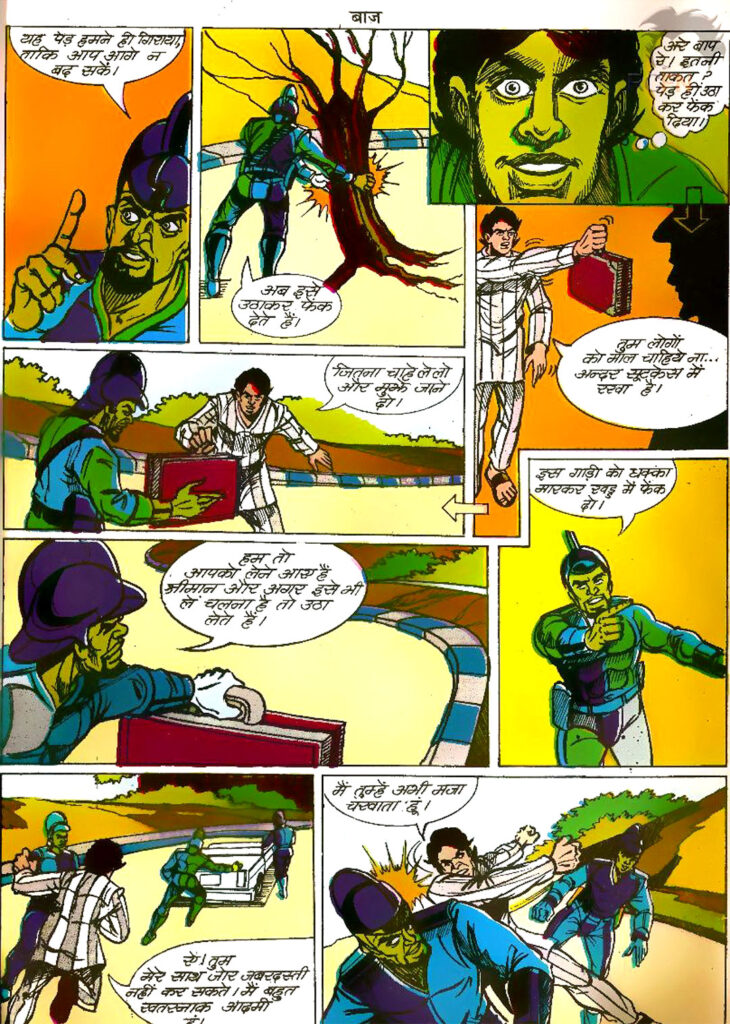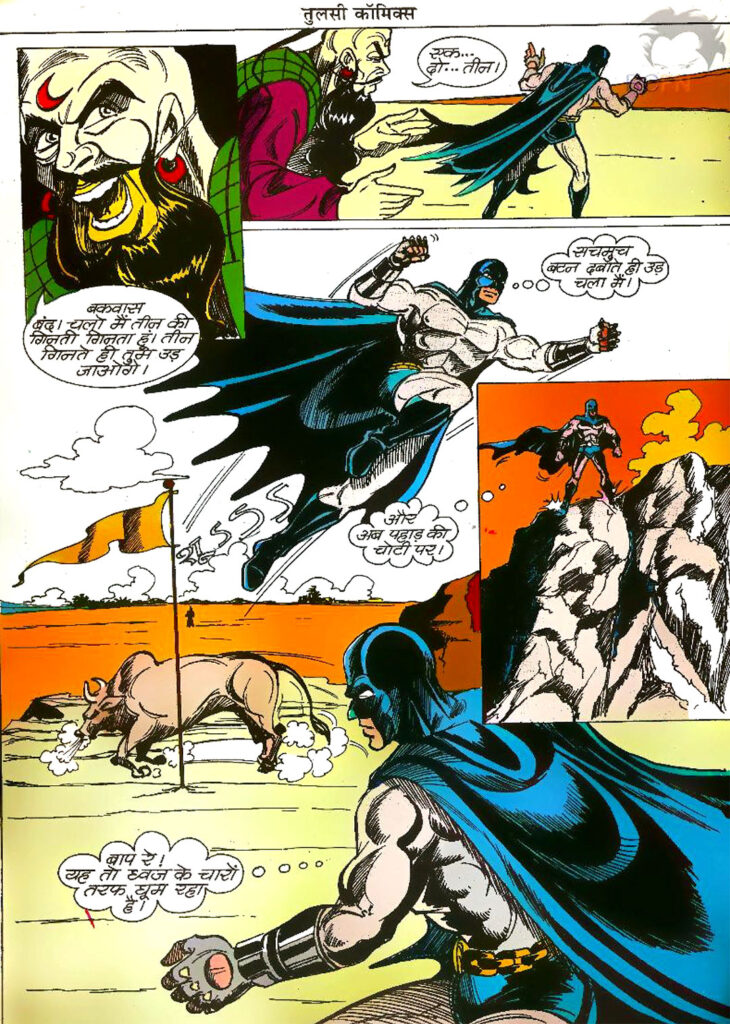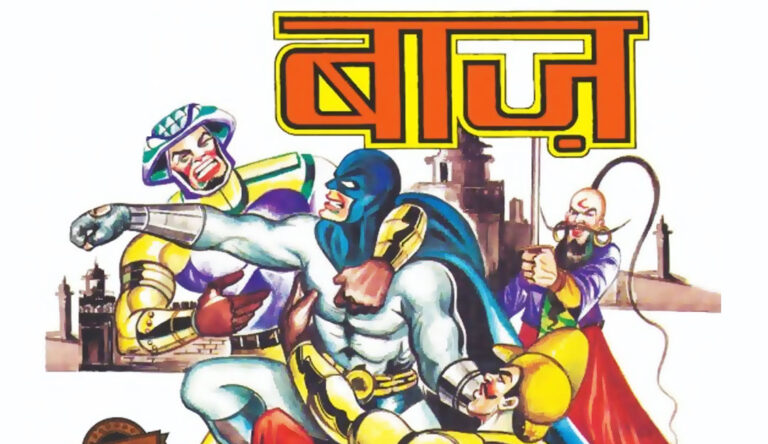Tulsi Comics had also created a special identity for itself among big names like Raj Comics, Diamond Comics, and Manoj Comics. From this publishing house emerged a hero whose story and concept are still a topic of discussion for comics lovers – “Baaz”. Decorated with the pen of writer Parshuram Sharma and the brush of painter Vikas Pankaj, this comic is an entertaining and action-packed presentation of its time. This story of “Baaz” is not just the story of a superhero, but it is an interesting tale of a criminal trapped in the whirlpool of identity, destiny, and circumstances, becoming a hero.
This review focuses on Issue No. 455, “Baaz”, of Tulsi Comics Digest, which takes us back to a period when the wings of imagination landed on paper and the reader was lost in a new world with every page. Let us, through this review, delve into the depths of the world of “Baaz” and see if this comic is as relevant and entertaining today as it was then.
A criminal, a prince, and an unwanted destiny
The beginning of the story is very straightforward and exciting. A notorious and dreaded criminal named Dev escapes from the jail of the border town Tarapur. The police are after him, and he wants to cross the border at any cost. On a stormy, rainy night, he blocks the path with stones to stop a cart on the highway. His intention is clear – to snatch the cart and run away. But from here the story takes a turn that Dev had not even imagined.

When the cart stops, out of it emerge soldiers in bizarre costumes, seemingly from another world. Dev attacks them with all his might, but they are not only much more powerful than him, they also address him as “Prince,” to his bewilderment. Even after Dev insists repeatedly that he is a criminal, they forcefully catch him and lock him in a bag.
When Dev’s eyes open, he finds himself in a grand royal bedroom. Fairy-like attendants are present at his service. He is told that he is in his palace. All this is like a puzzle for Dev. He tries to escape from this golden cage, but there are tight guards everywhere. He is soon presented to the ruler of this mysterious place, “Gurudeva.” Gurudeva, an influential and mysterious man, tells him that he is the lost prince of Devlok, and after years of penance they have finally been able to find him.
Dev cannot understand this drama. He repeatedly tells his truth, but no one listens to him. Gurudev assures him that his parents, i.e., Maharaj and Maharani, are in the captivity of an evil enemy “Yoddha” (Warrior), and it is now the responsibility of the prince to rescue them. There is a deep conspiracy behind this entire story, which Dev is not able to understand yet. Gurudev puts him through many difficult trials to prove him a prince and prepare him for the coming battle. In these trials, he has to show his physical strength, intelligence, and courage.
The most important turning point of the story comes when Gurudev gives him the royal attire of Devlok to wear. The costume is exactly like that of the famous DC Comics hero “Batman” – a black mask, a cowl with pointed ears, and a long cape resembling bat wings. As soon as he wears this outfit, the criminal Dev transforms into the hero “Baaz”.
In the beginning, Dev does all this just to save his life and find a chance to escape, but gradually he starts getting into this role. He passes every test of Gurudev, amazes everyone with his extraordinary abilities, and unknowingly starts winning the trust of people he does not even know. The story progresses, and Gurudev starts doubting Dev. He begins to believe that Dev is not a real prince but an impostor, and when he tells this to Maharaj, the king orders him to capture Dev dead or alive.
Now Dev faces a big challenge. He not only has to save his life but also has to run away from there. A criminal, who was forced to pretend to be a hero, now willingly becomes Baaz – the protector of humanity. The comic ends with an exciting battle and the sequel “Baaz Ka Terror” being announced, promising readers more action.
Characterization: Heroes, villains, and people in between
Dev/Baaz: The hero of this comic is not a traditional superhero, and that’s what makes him special. Dev comes before us as a harsh, selfish, and violent criminal. He only cares about himself. But when circumstances push him into the role of a hero, a new aspect of his character emerges. His transformation does not happen suddenly. He is confused, angry, and constantly on the run. The fighting skills and inherent courage that come from his criminal background make him an effective hero. This is a classic example of an anti-hero becoming a hero, which is beautifully presented in Indian comics.

Gurudev: He wears the mask of an ideal advisor and guru. His long beard, tilak on his head, and mysterious aura give him an impressive personality. He is a skilled planner who has woven an elaborate web to trap Dev and get his work done. His character teaches us that things are not always as they seem.
Vaman and other soldiers: Followers of Gurudev, such as the security officer Vaman, are straightforward and completely loyal to their “prince.” They blindly follow Gurudev’s orders, believing that they are doing the right thing. They add a touch of both humor and action to the story. Their immense power and their insistence on considering Dev as a prince help in driving the story forward.
Art and Painting: Vikas Pankaj’s Perspective
Vikas Pankaj’s artwork is a classic example of the 90s Indian comics genre. There is a rawness and dynamism in his art that brings the action scenes of the story to life.
Character Design: The character design of Baaz is undoubtedly inspired (or rather imitated) by Batman. Taking inspiration from foreign heroes was common in that period, and Tulsi Comics also adopted it. While on one hand it shows a lack of originality, on the other hand it is also a hallmark of that period and creates a unique attraction for today’s readers. The design of Gurudev and his soldiers is reminiscent of characters from Indian mythology and fantasy stories, giving a desi touch to the narrative.
Action Sequences: The action scenes of the comic are very energetic. The speed and impact are clearly visible in the panels designed to represent the moments of the fight. “Hulk!”, “Dham!”, “Shpak!” – sound effects (Calligraphy: Aradhana Varma, Pramila Jain) bring life to these scenes and double the fun of reading.
Use of Colors: The colors used in the comic are very bright and vibrant, which was characteristic of the printing technology of that time. These colors further enhance the dramatic atmosphere of the story and give it a vintage look that old comics lovers will immensely enjoy.
Subject and Basic Feeling
“Baaz” is more than just an action comic. It touches on a number of interesting themes:
The story revolves around the identity crisis, where a criminal is assumed to be a prince, raising the deep question of whether our identity is rooted in our true nature or in the perception of the world. The story depicts the dichotomy of destiny versus karma, suggesting that although circumstances determine our role, ultimately it is our choices and karma that make us heroes or villains. Dev’s journey from a criminal to a protector is a powerful saga of redemption, which reinforces the belief that the spark of goodness can be awakened in anyone. Additionally, the character of Baaz presents a successful Indianization of the concepts of Western superheroes into the Indian narrative genre, which made this comic a unique and memorable piece.
Conclusion: Can the “hawk” still fly today?
So the question arises whether “Baaz” can entertain readers even in today’s times? The answer is – yes, of course.
This comic is a mirror of its time. Its story is fast-paced, it has the right mix of suspense and adventure, and its original concept of a criminal becoming a hero is just as fascinating today. Yes, its similarity to Batman puts a question mark on originality, but the desi style and powerful action of the story make up for this shortcoming to a great extent.
“Baaz” is an important comic for those who want to know the history of Indian comics. It’s a fun and action-packed story for younger readers, and for older readers, it’s a whiff of sweet memories of days gone by. Parashuram Sharma and Vikas Pankaj together created a hero who may not be completely original, but his story had merit.
Finally, “Baaz” is a masterpiece from Tulsi Comics that should not be forgotten. It is proof that there has always been a place for new and unique stories in the Indian comics industry. If you love action, fantasy, and comics with a strong story, the flight of “Baaz” won’t let you down.
